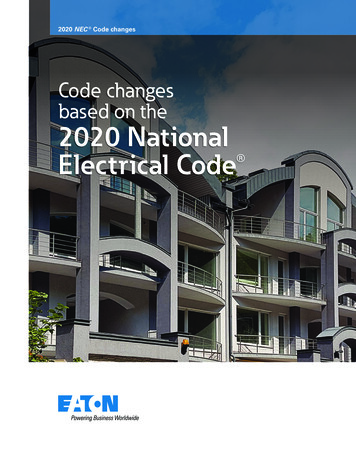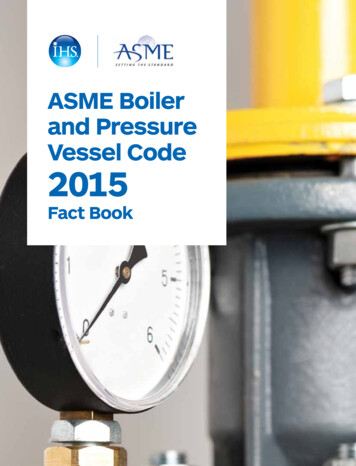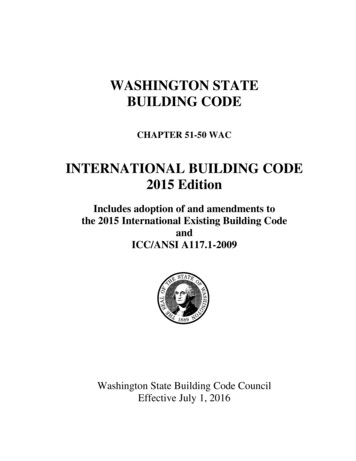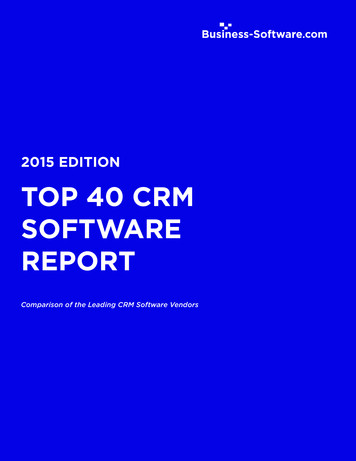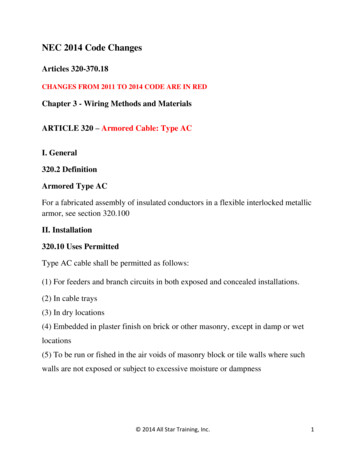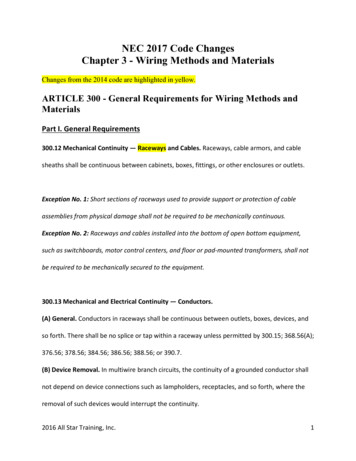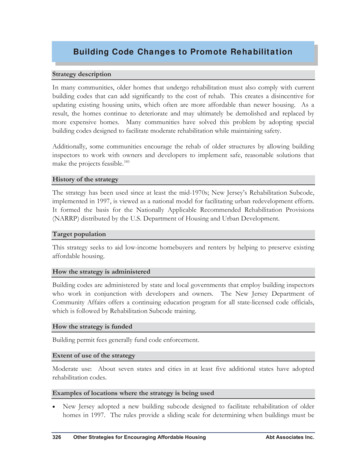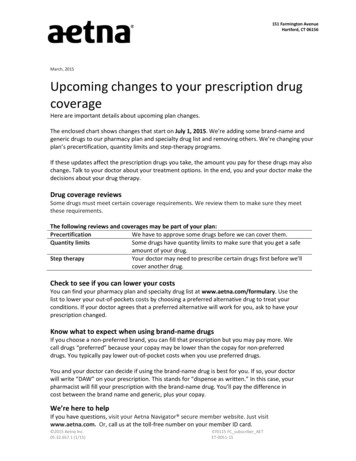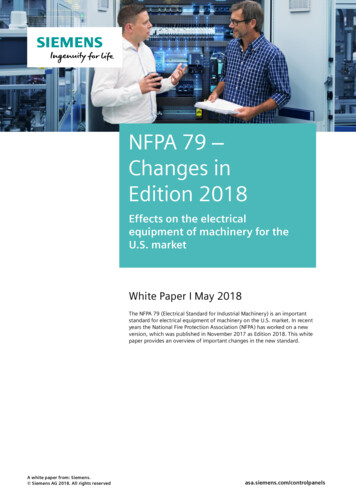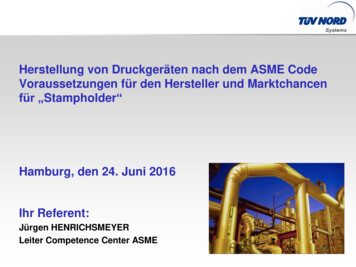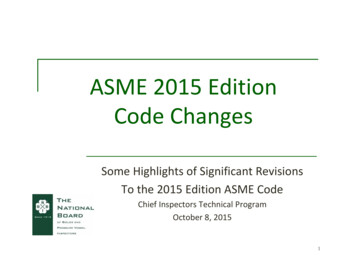
Transcription
ASME 2015 EditionCode ChangesSome Highlights of Significant RevisionsTo the 2015 Edition ASME CodeChief Inspectors Technical ProgramOctober 8, 20151
ForewordIn the 2015 Edition, recognition of the TechnicalOversight Management Committee (TOMC) hasbeen added to the Forward. TOMC has responsibility for technical consistencyof the Sections of the Code and coordination ofstandards development activities.BPV Main Committee was replaced by TOMC2
Section I3
Section IInterpretation: Section I, Preamble, Definition of Connection to BoilerQuestion:The fourth paragraph of the Preamble defines the point where boiler external piping beginsin terms of where the boiler proper terminates at, as follows:(a) the first circumferential joint for welding end connections; or(b) the face of the first flange in bolted flanged connections; or(c) the first threaded joint in that type of connection; and which extends up to andincluding the valve or valves required by this Code.In the case of boilers where the connection contains one or more fittings between the boilerand final point of connection (e.g. welding neck, elbow or tee), must the Manufacturer listthe first of any circumferential weld joint, flange face, or threaded joint as the connection onthe Manufacturer’s Data Report?Reply:No, one or more fittings may exist between the boiler and external piping provided theManufacturer defines where the boiler proper terminates and BEP begins.4
Section IPG‐112 – Guidance on use of data report forms New guidance provided for the use of Form P‐3, Form P‐4,and Form PL‐15
Section IItem Number 14‐418: Section I, Table A‐360 – Reference to B16.25 Year of publication of all ASME standards listed in ANSI B16.25Mandatory Appendix II removed so that the latest editions of ASMEpublications apply.ASME Section I 2015 Ed.ASME B16.25 2012 Ed.6
Section IPreamble – Addition of solar heated steamgenerator Includes solar receiver steam generators in the scope ofASME Section I Preamble Note 6 – “Solar receiver steam generator – aboiler system in which water is converted to steam usingsolar energy as the principle source of thermal energy.The solar energy is typically concentrated onto the solarreceiver through the use of an array of mirrors that focussolar radiation on the heat transfer surface.”7
Section IPG‐105.2 ‐ Adoption of ASME CA‐1 standard Includes ASME CA‐1 standard in requirements forobtaining and maintaining a Certificate of Authorization New paragraph PG‐105.2 – “Any organization desiring aCertificate of Authorization shall apply to ASME inaccordance with the certification process of ASME CA‐1.Authorization to use Certification Marks may be granted,renewed, suspended, or withdrawn as specified in ASMECA‐1.”8
Section IAdoption of the new ASME CA‐1 Standard9
Section IParts fabrication certificate program New “PRT” fabricated parts designator added for ASMECertification Mark New paragraph in Table A‐370: “Certification Mark with ‘PRT’ Designator”‒ Manufacture of parts without design responsibility for ASME Section Iat the above location only.‒ Manufacture of parts without design responsibility for ASME Section Iat the above location and field sites controlled by the above location.” The new program will allow organizations to fabricate parts forother Code Sections (other than Section VIII) based ondemonstration capabilities without having to either performand/or demonstrate design.10
Section I11
Section I12
Section IPart PL – Requirements for Locomotive Boilers New Part PL added on requirementsfor locomotive boilers PL‐1 GENERAL“The rules in this Part are applicable to steamlocomotive boilers and their parts andappurtenances. These rules shall be used inconjunction with the general requirements inPart PG, and the specific requirements in theapplicable Parts of this Section that apply tothe method of fabrication used.”1952 EditionMechanical Engineering No. 10 Oct 201513
Section IPG‐11 Prefabricated or Preformed Pressure Parts ‐Rewrite Section I rules are now verysimilar to Section VIII Div. 1UG‐11 requirements. Parts must comply with applicable rules, including design.Parts must be supported by P/Trating documentation (whennecessary) to demonstrate Codecompliance.Certificate Holders can subcontractwelded part fabrication to non‐certificate holder14
Section IPW‐16.8 ‐ New ParagraphOxide Growth Cracking between the stub tube weldand the header is a common problemoccurring in high temperature boilerheaders. One of the leading causes ofthis cracking is the stress caused byoxide growth between the tube stuband the header.PW‐16.8 was added requiring hightemperature socket type tubeattachment to be designed to avoid theaccumulation of oxide for ferriticmaterials designed for 900 F or higher15
Section I16
Section IV17
Section IVHG‐307.5 ‐ Electric Immersion Heating SupportPlates The 2015 change will now allow a Boiler Manufacture tosupply these elements as miscellaneous pressure parts.1.2.3.Designed and fabricated as a flat head in accordance with HG‐307 and HG‐325.Designed and certified in accordance with Section VIII Div. 1Appendix 41 orSupplied as a Manufacturer’s standard pressure part inaccordance with HF‐203.18
Section IVPneumatic Testing Code Cases (2604 for cast aluminum sections and 2469‐1 for heating boilers) and their limitations have nowbeen incorporated into Section IVA New paragraph HG‐511 was added to permit thepneumatic testing of boilers in lieu of a hydrostatic test.19
Section IVHG‐520.4 – Multiple Page Data Reports“Requirements for completing multiple pages of DataReport Forms are shown in Appendix 4.” Nonmandatory Appendix L was changed toMandatory Appendix 4‒ Mandatory Appendix 4‐100 (a) – “The following pagesare a guide for completing the Manufacturer’s DataReport Forms.”‒ Additional requirements for multiple page data reportswere added to Mandatory Appendix 420
Section IV21
Section IVHC‐214Welding on cast sectionrequirementsHC‐214 Workmanship, Finish,And Repair22
Section IVManufacturers with multiple locations HG‐520.2 (c) – “Manufacturers with multiple locations,each with its own Certificate of Authorization, maytransfer parts from one its locations to another withoutPartial Data Reports, provided the Quality Control Systemdescribes the method of identification, transfer, andreceipt of the parts.” Identical new paragraph also added to HLW‐601.2 (c)23
Section IV HLW‐601.2 added (c)for Multiple LocationsHLW‐601.4 added forMultiple Page DataReports24
Section IVHG‐530 – Marking of boilers HG‐530.1 (b) – “the information listed in (a) above, including theCertification Mark, shall be applied by stamping or etching that leavesa permanent, legible mark.”‒ “The process controls for etching shall be described in the Quality ControlSystem and shall be acceptable to the Authorized Inspector.”‒ “The process controls shall be established so that the etched charactersshall be at least 0.004 in (0.10 mm) deep.” HG‐530.2 (g)(4) – “marking the required data on a nonmetallicnameplate at least 3 in. x 4 in. (75mm x 100 mm) in size using lettersand numerals at least 1/8 in. (3 mm) high and permanently attachingthe nameplate to the casing in some conspicuous place by an adhesivesystem.”HG‐530.2 (g)(5) – “the nameplate and the adhesive system shall meetthe requirements of Appendix 3 ”25
Section IVSection IV, Mandatory Appendix 2 Latest edition of QAI‐1 referenced in MandatoryAppendix 2 HG‐402.2, HG‐515.2 (n) – Certified Individualscertifying Manufacturer’s Data Reports must meet therequirements of the current edition of ASME QAI‐1HG‐512.2 Manufacturer’s Responsibilities26
Section V27
Section VT‐120(g) – added Reference to New Article 1,Mandatory Appendix II. It was decided to maintain the references to the 2006Edition of SNT‐TC‐1A and add the requirements for thenew techniques in radiography and ultrasonic methodsto the new Article 1, Mandatory Appendix II.T‐150(d) reaffirms that it is the prerogative of the Construction Codewhether or not to implement these additional qualificationrequirements.The 2015 Edition Construction Code Sections have not implementedMandatory Appendix II as a requirement, but some are activityconsidering it.28
Section VArticle 7, T‐762 – Lifting Power of Yokes T‐762 now states that the “magnetizing power of yokesshall be verified prior to use each day the yoke is used,”and goes on to state “The magnetizing power of yokes shallbe verified whenever the yoke has been damaged orrepaired.” Revisions to MT procedures may be required due to this substantialchange.29
Section VArticle 1 Mandatory Appendix 1 – Revised andconsolidated Glossary of Terms. Terms and definitions were consolidated andincorporated alphabetically by method.The Term “Examination” was added to differentiatefrom “Inspection.”30
Section VIII Div. 131
Section VIII Div. 1Revisions to U‐2(b) & U‐2(e) make clarificationof the manufactures and AI duties as it relates todesign calculations:32
Section VIII Div. 1 U‐2(e) ‐ This implies that as a minimum, thedesign calculations will be checked relative tothe loadings identifiedcorrect equation and thecorrect values such as allowable stress, jointefficiency and dimensions.33
Section VIII Div. 1UW‐3(a) & UW‐11(a)(7) ‐Weld seam in Tubesheet Due to the complexity and multiple steps associatedwith Part UHX tubesheet design, the committee electedto mandate full radiography for any butt weld seamwithin a tube sheet regardless of thickness or servicecondition.UW‐3(a) now definesany butt‐welded jointwithin a flat tubesheetas a Category A34
Section VIII Div. 1Figure UG‐118; Division 2, Figure 2.F.1; Division3, Figure KS‐132“USER” shall be stampedabove the certificationmark on the nameplateif inspected by a user’sinspector (UG‐91)35
Section VIII Div. 1U‐1(g)(1), UG‐116, UG‐120 Required MarkingsNew paragraph UG‐116 (f) –“An unfired steam boiler,referenced in U‐1 (g)(1),shall have its maximumdesigned steaming capacityrecorded in the ‘Remarks’section of the data report.”36
Section VIII Div. 1New Data Report Form for Plate Heat Exchanges Form U‐1P requires specificinformation regarding theend plates, and the heattransfer plates, includingthe maximum plate countfor the frame and theassembly, quantity ofplates in the PHE as testedand shipped.37
Section IX38
Section IXEffective date of Section IXWhen the forward was previously revised, some of the ruleswere removed. Therefore QG‐100 (d) & QG‐100(e) wasadded New paragraph QG‐100(d) – “New editions to Section IX may beused beginning with the date of issuance and become mandatory sixmonths after the date of issuance.”New paragraph QG‐100(e) – was added to establish the effectivedate of Section IX Code Cases39
Section IXQG‐106 – Procedure and PerformanceQualifications Modified paragraph QG‐106.1 (a) ‐ “The personnel whoproduce test joints for procedure qualification shall beunder the full supervision and control of the qualifyingorganization during the production of these test joints.” Modified paragraph QG‐106.2 (a) – “The personnelwho produce test joints for performance qualificationshall be tested under the full supervision and control ofthe qualifying organization.”40
Section IXQW‐220 – Hybrid Welding Procedures due to the requests to include other hybridprocesses, (other than Hybrid Laser‐GMAW and Hybrid Plasma‐GMAW). Paragraphs QW‐220 and QW‐221 were rewrittenNew paragraphs QW‐222 and QW‐223 were added41
Section IXQW‐423.1– Unassigned base metals used inwelder qualifications Expanded table to include the same guidance as listed inQW‐424.1 for welding unassigned base metals:Base Metals for WelderQualificationQualified Production BaseMetalsAny unassigned metal to thesame unassigned metalThe unassigned metal to itselfAny unassigned metal to any P‐Number metalThe unassigned metal to anymetal assigned to the same P‐Number as the qualified metalAny unassigned metal to anyother unassigned metalThe first unassigned metal to thesecond unassigned metal42
Section X43
Section XAdopted CA‐1 Standard – Latest Edition44
2015
ASME Section I 2015 Ed. ASME B16.25 2012 Ed. Section I Preamble –Addition of solar heated steam generator Includes solar receiver steam generators in the scope of ASME Section I Preamble Note 6–“Solar receiver steam generator –a boiler system in which water is converted to steam using solar energy as the principle source of thermal energy. The solar energy is typically .
